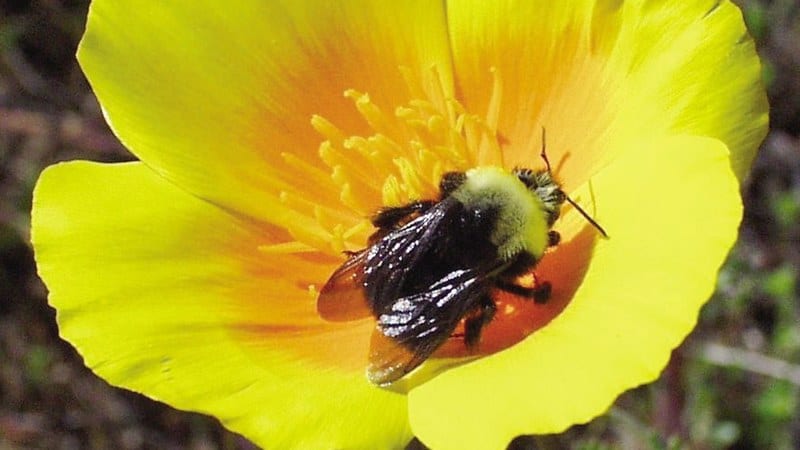
Franklin’s Bumblebee Facts
- This somewhat diminutive marvel of Nature and evolution most frequently goes by the simple common name of Franklin’s Bumblebee. For the moment, the remarkable insect has no other accepted general name. Though certainly not unknown, that’s slightly uncommon.
- Among scientific professionals, however, it’s much better known by its technical title. Fortunately for the layperson, that’s a much simpler to pronounce term than many such monikers. That’s because it bears the simple official title of the Bombus franklini.
- The beautiful invertebrate received that formal title due to the efforts of the American entomologist, Theodore H. Frison. The respected scientist accomplished the first recognition of the creature as a separate and distinct species. He managed that feat in the year 1921.
- Despite its simple appearance, this marvelous Arthropod stands out from its relatives in several ways. One of those is an unfortunate one, though. That holds true due to the fact that the invertebrate inhabits one of the smallest ranges of any of known bumblebee variety.
- Sadly, this fact severely limits the possibilities for the delicate Franklin’s Bumblebee. Its numbers began dwindling rapidly in recent years. Between 1998 and 2005, sightings plummeted sharply. No confirmed individual of this species has even been seen since 2006.
- It’s entirely possible, in fact, though not yet certain, that it’s now extinct. For the moment, the IUCN lists it as Critically Endangered. Even if a few do still survive, they face extreme threats to their existence. These include the perils of habitat loss and climate change.
Related Articles
Franklin’s Bumblebee Physical Description
The captivating Franklin’s Bumblebee always impresses those people fortunate enough to encounter one, and recognize it. The bee does so due to the differences in its appearance that distinguish it from other bumblebees, however. It does not do so, though, due to its sheer physical size.
That’s due to the obvious fact that, like its many relatives, it’s a very small variety of invertebrate. Much like them, it also displays a certain degree of the physiological characteristic of sexual dimorphism. In its specific case, though, this trait manifests in terms other than measurements.
Intriguingly, males of this intriguing Arthropod develop one more abdominal segment than their female counterparts. Females, meanwhile, display a slightly different patter of coloring than the males. The overall difference in appearance remains minor to the untrained observer, though.
Both genders of the Franklin’s Bumblebee display a solid black abdomen. That small characteristic separates them from all other known bumblebees. Both sexes additionally manifest light yellow hair on the anterior portion of the thorax. Uniquely, this also develops in a U-shaped pattern.
The head and face of both genders of the beautiful insect present a predominantly black background. Individuals do, however, display a very small patch of yellow at the top of the head. At the tip of the abdomen in both genders, an equally tiny white patch also typically appears.
- Kingdom: Animalia
- Phylum: Arthropoda
- Class: Insecta
- Order: Hymenoptera
- Family: Apidae
- Genus: Bombus
- Species: B. franklini
Franklin’s Bumblebee Distribution, Habitat, and Ecology
The visually distinctive wonder that’s the Franklin’s Bumblebee evolved as native to a region of the world well known for its numerous natural marvels. Unfortunately, however, its portion of that area seems to be extremely limited. It lives in only a tiny part of what’s now North America.
The beautiful insect apparently lives in only a small range of the United States. More precisely, its only known range consists of portions of Oregon and California. Even there, though, the insect is just known to exist in a region that measures roughly 190 mi by 70 mi (310 km by 110 km).
For the moment, it remains undetermined if the bee ever appeared anywhere else in the world. Within that tiny range, though, it does, at least, display an adaptability to different habitat types. The broadly evolved biological wonder simply requires the presence of sufficient flowering flora.
Impressively, the intrepid invertebrate also makes its home at a comparatively wide range of altitudes. In the more northern section of its tiny range, it’s been seen at altitudes as low as only 540 ft (162 m) above sea level. Further south, however, it’s been spotted at 7,800 ft (2,340 m).
Much like similar species, the Franklin’s Bumblebee lives and functions as a eusocial creature. It lives in colonies consisting of a queen and her offspring, both males and sterile female workers. Its exact nesting strategy remains unknown, but it’s believed to prefer abandoned burrows.
The workers of the species, rarely exceeding 400, acquire food from a wide variety of flowering plants. Nectar serves as the primary food source of mature adults. The young, however, require a higher nutritional content. For them, workers gather pollen from the same local plant sources.
Species Sharing Its Range
Check out our other articles on 3 Enchanting Marvels of Ethiopia, Amazonian Manatee, Mount Kinabalu, Southern Darwin’s Frog, Philippine sailfin lizard, West Indian Ocean Coelacanth
